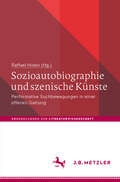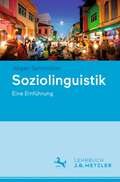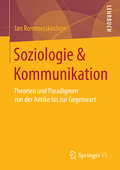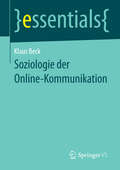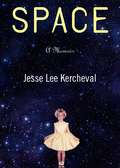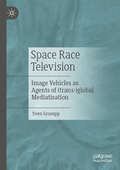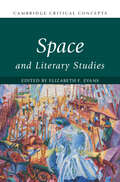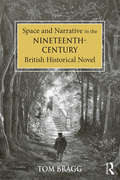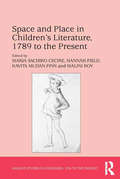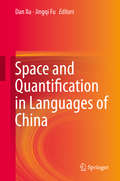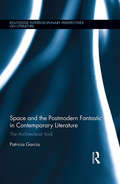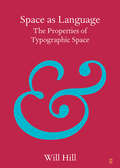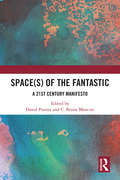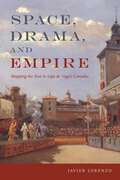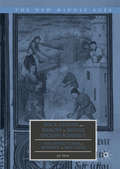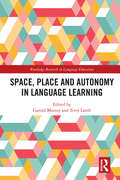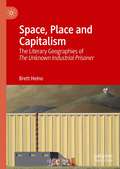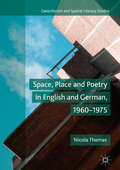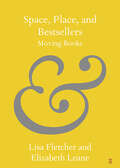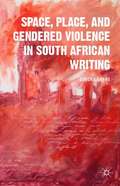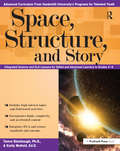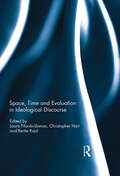- Table View
- List View
Soy Bilingue: Language, Culture and Young Latino Children
by Sharon Cronin Carmen Sosa MassóSoy Bilingue : Language, Culture and Young Latino Children
Sozioautobiographie und szenische Künste: Performative Suchbewegungen in einer offenen Gattung (Abhandlungen zur Literaturwissenschaft)
by Raffael HidenGesellschaftsdiagnosen durchkreuzen die Soziologiegeschichte in sehr unterschiedlichen Formen. Während sich geschichtsphilosophische Traditionslinien weitestgehend verflüchtigt haben, bestimmen aktuell interdisziplinäre und intermediale Experimentierfelder das Geschäft der Gesellschaftsdiagnose. Gegenwärtig wird diese Gattung mit performativen Instrumentarien erweitert, die im Zusammenhang stehen mit 'sozioautobiographischen' Schreibweisen . Gesellschaft wird hier zusehends mit dem Aufzug von Figuren und figurativen Darstellungsmodi an der Schnittstelle von Autobiographie und soziologischer Reflexion verhandelt. Dieser Band nimmt sich dieser Konjunktur an und versammelt Beiträge zur aktuellen Tendenz der szenischen Adaption bzw. Neuausrichtung dieser Stoffe, die anhand exemplarischer Fallbeispiele (u.a. Elfriede Jelinek, Milo Rau, Kim de l'Horizon) dargelegt werden.
Soziolinguistik: Eine Einführung
by Jürgen SpitzmüllerDie Soziolinguistik fragt nach der Verwobenheit von Sprache und Gesellschaft und den zahlreichen damit zusammenhängenden Aspekten. Der Band bietet für den deutschsprachigen Raum die erste systematische Einführung in die aktuellen Theorien, Begriffe und Methoden. Eingangs stehen die theoretischen Grundlagen sowie die Geschichte der Soziolinguistik im Fokus. Die Hauptteile behandeln mit der Variationslinguistik, der interaktionalen Soziolinguistik sowie der kritischen und metapragmatischen Soziolinguistik die gegenwärtigen Hauptströmungen. – Mit Definitionen, Vertiefungen und Beispielstudien.
Soziologie & Kommunikation: Theorien und Paradigmen von der Antike bis zur Gegenwart
by Jan RommerskirchenDas Lehrbuch stellt die Entwicklung soziologischer und kommunikationstheoretischer Ansätze von der Antike bis zur Gegenwart vor. Die wichtigsten Theorien und Theoretiker werden im fachspezifischen und historischen Kontext vorgestellt und interdisziplinär behandelt: Platon und Aristoteles, Thomas Hobbes, Adam Smith und Immanuel Kant, Karl Marx und Max Weber sowie die Pragmatisten und die Systemtheorien von Talcott Parsons und Niklas Luhmann, aber auch George C. Homans und Ralf Dahrendorf sowie die neueren Ansätze von John Searle, Jürgen Habermas und Robert Brandom werden erläutert. Den Studierenden werden dadurch die Gemeinsamkeiten und Differenzen der wichtigsten klassischen und aktuellen soziologischen und kommunikationstheoretischen Ansätze vermittelt.
Soziologie der Online-Kommunikation (essentials)
by Klaus BeckVon einem kommunikationssoziologisch fundierten und medientheoretisch differenzierten Medienbegriff ausgehend wird eine Systematik der Online-Kommunikation entwickelt und begründet. In diesem Zusammenhang werden Medien als institutionalisierte und technisch basierte Zeichensysteme zur organisierten Kommunikation und das Internet als technische Plattform oder Mediennetz verstanden. Es werden Kriterien entwickelt sowie unterschiedliche Systematisierungsansätze diskutiert, um einzelne Internetdienste als Modi der Online-Kommunikation bzw. Handlungsrahmen computervermittelter Kommunikation zu beschreiben.
Spa Culture and Literature in England, 1500-1800 (Early Modern Literature in History)
by Sophie Chiari Samuel Cuisinier-DelormeThis edited collection aims at highlighting the various uses of water in sixteenth, seventeenth, and eighteenth-century England, while exploring the tensions between those who praised the curative virtues of waters and those who rejected them for their supposedly harmful effects. Divided into three balanced sections, the collection includes contributions from renowned specialists of early modern culture and literature as well as rising young scholars as it seeks to establish a dialogue between different methodologies, and explain why the spa-related issues examined still resonate in today’s society.
Space
by Jesse Lee KerchevalJesse Lee Kercheval opens her story in Cocoa, Florida, in 1966 as a precocious ten-year-old whose family-father, mother, two little girls-is trying to ride the Space Race's tide of optimism. But even as the rockets keep going up, the Kercheval family slowly spirals down.
Space Race Television: Image Vehicles as Agents of (trans-)global Mediatisation
by Sven GramppThis volume offers a media-theoretically oriented perspective on the Space Race. It analyzes feature films, documentaries, live television coverage, magazines, stamps, posters, ticker-tape parades. They visualized the Space Race in a specific way and circulated it transnationally from 'East' to 'West' and from 'West' to 'East' across the 'Iron Curtain'. It will be shown how reporting on the Space Race between 1955 and 1975 can be explained as a globalizing history of the intertwining of images during the Cold War.
Space and Literary Studies (Cambridge Critical Concepts)
by Elizabeth F. EvansOur experience of the world is deeply shaped by concepts of space. From territorial borders, to distinctions between public and private space, to the way we dwell in a building or move between rooms, space is central to how we inhabit our environment and make sense of our place within it. Literature explores and gives expression to the ways in which space impacts human experience. It also powerfully shapes the construction and experience of space. Literary studies has increasingly turned to space and, fuelled by feminist and postcolonial insights, the interconnections between material spaces and power relations. This book treats foundational theories in spatial literary studies alongside exciting new areas of research, providing a dual emphasis on origins and innovative approaches while maintaining constant attention to how the production and experience of space is intertwined with the production and circulation of power.
Space and Narrative in the Nineteenth-Century British Historical Novel
by Tom BraggDemonstrating that nineteenth-century historical novelists played their rational, trustworthy narrators against shifting and untrustworthy depictions of space and place, Tom Bragg argues that the result was a flexible form of fiction that could be modified to reflect both the different historical visions of the authors and the changing aesthetic tastes of the reader. Bragg focuses on Scott, William Harrison Ainsworth, and Edward Bulwer Lytton, identifying links between spatial representation and the historical novel's multi-generic rendering of history and narrative. Even though their understanding of history and historical process could not be more different, all writers employed space and place to mirror narrative, stimulate discussion, interrogate historical inquiry, or otherwise comment beyond the rational, factual narrator's point of view. Bragg also traces how landscape depictions in all three authors' works inculcated heroic masculine values to show how a dominating theme of the genre endures even through widely differing versions of the form. In taking historical novels beyond the localized questions of political and regional context, Bragg reveals the genre's relevance to general discussions about the novel and its development. Nineteenth-century readers of the novel understood historical fiction to be epic and serious, moral and healthful, patriotic but also universal. Space and Narrative in the Nineteenth-Century British Historical Novel takes this readership at its word and acknowledges the complexity and diversity of the form by examining one of its few continuous features: a flexibly metaphorical valuation of space and place.
Space and Place in Children’s Literature, 1789 to the Present (Studies in Childhood, 1700 to the Present)
by Maria Sachiko Cecire Hannah Field Malini RoyFocusing on questions of space and locale in children’s literature, this collection explores how metaphorical and physical space can create landscapes of power, knowledge, and identity in texts from the early nineteenth century to the present. The collection is comprised of four sections that take up the space between children and adults, the representation of 'real world' places, fantasy travel and locales, and the physical space of the children’s book-as-object. In their essays, the contributors analyze works from a range of sources and traditions by authors such as Sylvia Plath, Maria Edgeworth, Gloria Anzaldúa, Jenny Robson, C.S. Lewis, Elizabeth Knox, and Claude Ponti. While maintaining a focus on how location and spatiality aid in defining the child’s relationship to the world, the essays also address themes of borders, displacement, diaspora, exile, fantasy, gender, history, home-leaving and homecoming, hybridity, mapping, and metatextuality. With an epilogue by Philip Pullman in which he discusses his own relationship to image and locale, this collection is also a valuable resource for understanding the work of this celebrated author of children’s literature.
Space and Quantification in Languages of China
by Dan Xu Jingqi FuThis volume provides general linguists with new data and analysis on languages spoken in China regarding various aspects of space and quantification, using different approaches. Contributions by researchers from Mainland China, Hong Kong, Japan, Europe, the United States and Australia offer insights on aspects of language ranging from phonology and morphology to syntax and semantics, while the approaches vary from formal, historical, areal, typological, and cognitive linguistics to second language acquisition. After separate volumes on space and quantification in languages of China, the studies in this volume combine space and quantification to allow readers a view of the intersection of the two topics. Each article contributes to general linguistic knowledge while discussing a particular aspect of space or quantification in a particular language/dialect, offering new data and analysis from languages that are spoken in the same geographical area, and that belong to various language families that exist and evolve in close contact with one another.
Space and the Postmodern Fantastic in Contemporary Literature: The Architectural Void (Routledge Interdisciplinary Perspectives on Literature)
by Patricia GarciaArising from the philosophical conviction that our sense of space plays a direct role in our apprehension and construction of reality (both factual and fictional), this book investigates how conceptions of postmodern space have transformed the history of the impossible in literature. Deeply influenced by the work of Jorge Luis Borges and Julio Cortázar, there has been an unprecedented rise in the number of fantastic texts in which the impossible is bound to space — space not as scene of action but as impossible element performing a fantastic transgression within the storyworld. This book conceptualizes and contextualizes this postmodern, fantastic use of space that disrupts the reader’s comfortable notion of space as objective reality in favor of the concept of space as socially mediated, constructed, and conventional. In an illustration of the transnational nature of this phenomenon, García analyzes a varied corpus of the Fantastic in the past four decades from different cultures and languages, merging literary analysis with classical questions of space related to the fields of philosophy, urban studies, and anthropology. Texts include authors such as Julio Cortázar (Argentina), John Barth (USA), J.G. Ballard (UK), Jacques Sternberg (Belgium), Fernando Iwasaki (Perú), Juan José Millás (Spain,) and Éric Faye (France). This book contributes to Literary Theory and Comparative Literature in the areas of the Fantastic, narratology, and Geocriticism and informs the continuing interdisciplinary debate on how human beings make sense of space.
Space as Language: The Properties of Typographic Space (Elements in Publishing and Book Culture)
by Will HillThis Element examines the function and significance of typographic space. It considers in turn the space within letters, the space between letters, the space between lines, and the margin space surrounding the text-block, to develop the hypothesis that viewed collectively these constitute as a 'metalanguage' complementary to the text. Drawing upon critical perspectives from printing, typeface design, typography, avant-garde artistic practice and design history, the Element examines the connotative values and philosophies embodied in the form and disposition of space. These include the values attributed to symmetry and asymmetry, the role of 'active' space in the development of modernist typography, the debated relationship between type and writing, the divergent ideologies of the printing industry and the letter arts, and the impact of successive technologies upon both the organisation and the perception of typographic space.
Space in Medieval Romance: Constructing Narrative Space in the Middle English Breton Lays (Geocriticism and Spatial Literary Studies)
by Fanny MoghaddassiThis book explores the connections between space and narrative through an in-depth analysis of the fourteenth-century Middle English Breton lays. The work employs a range of critical approaches pertaining to the spatial turn and geocriticism and presents a nuanced account of the construction of narrative space in fourteenth-century English romance. In her study, Fanny Moghaddassi offers a theoretical reflection on the literary specificities of romance space, provides an examination of the social, political, and ideological tensions at work in its representation, and considers medieval practices of space, both from a collective and a more individual point of view.
Space(s) of the Fantastic: A 21st Century Manifesto
by David Punter; C. Bruna ManciniThis book provides a series of new addresses to the enduring problem of how to categorize the Fantastic. The approach taken is through the lens of spatiality; the Fantastic gives us new worlds, although of course these are refractions of worlds already in being. In place of ‘real’ spaces (whatever they might be), the Fantastic gives us imaginary spaces, although within those spaces historical and cultural conflicts are played out, albeit in forms that stretch our understanding of everyday location, and our usual interpretations of cause and effect. Many authors are addressed here, from a variety of different geographical and national traditions, thus demonstrating how the Fantastic - as a mode, a genre, a way of thinking, imagining and writing - continually traverses borders and boundaries. We hope to move the ongoing debate about the Fantastic forward in a scholarly as well as an engaging way.
Space, Drama, and Empire: Mapping the Past in Lope de Vega's Comedia (Campos Ibéricos: Bucknell Studies in Iberian Literatures and Cultures)
by Javier LorenzoSpanish poet, playwright, and novelist Félix Lope de Vega (1562–1635) was a key figure of Golden Age Spanish literature, second only in stature to Cervantes, and is considered the founder of Spain’s classical theater. In this rich and informative study, Javier Lorenzo investigates the symbolic use of space in Lope’s drama and its function as an ideological tool to promote an imagined Spanish national past. In specific plays, this book argues, historical landscapes and settings were used to foretell and legitimize the imperial present in Hapsburg Spain, allowing audiences to visualize and plot, as on a map, the country’s expansionist trajectory throughout the centuries. By focusing on connections among space, drama, and empire, this book makes an important contribution to the study of literature and imperialism in early modern Spain and equally to our understanding of the role and political significance of spatiality in Siglo de Oro comedia.
Space, Gender, and Memory in Middle English Romance
by Jan ShawThis book offers a much-needed consideration of Melusine within medieval and contemporary theories of space, memory, and gender. The Middle English Melusine offers a particularly rich source for such a study, as it presents the story of a powerful fairy/human woman who desires a full human life--and death--within a literary tradition that is more friendly to women's agency than its continental counterparts. After establishing a "textual habitus of wonder," Jan Shaw explores the tale in relation to a range of Middle English traditions including love and marriage, the spatial practices of women, the operation of individual and collective memory, and the legacies of patrimony. Melusine emerges as a complex figure, representing a multifaceted feminine subject that furthers our understanding of Middle English women's sense of self in the world.
Space, Place and Autonomy in Language Learning (Routledge Research in Language Education)
by Garold Murray Terry LambThis book explores theories of space and place in relation to autonomy in language learning. Encompassing a wide range of linguistically and culturally diverse learning contexts, this edited collection brings together research papers from academics working in fourteen countries. In their studies, these researchers examine physical, virtual and metaphorical learning spaces from a wide range of theoretical and interdisciplinary perspectives (semiotic, ecological, complexity, human geography, linguistic landscapes, mediated discourse analysis, sociocultural, constructivist and social constructivist) and methodological approaches. The book traces its origins to the first-ever symposium on space, place and autonomy, which was held at the International Association of Applied Linguistics (AILA) 2014 World Congress in Brisbane. The final chapter, which presents a thematic analysis of the papers in this volume, discusses the implications for theory development, further enquiry, and pedagogical practice.
Space, Place and Capitalism: The Literary Geographies of The Unknown Industrial Prisoner
by Brett HeinoThis book is an original contribution to literary geography and commentaries on the work of David Ireland. It plots the relationship between the spaces and places of 1970s Australian capitalism as it evolves through Ireland’s 1971 Miles Franklin prize-winning novel The Unknown Industrial Prisoner. In particular, the book theorises the relationship between space and place in literature through two highly innovative arguments: a focus on the spatial unconscious as a means to assess and track the spatiality of capitalism in the novel form; and the articulation of a regime of space through the perceived, conceived and lived constitution of space. Drawing together concepts from radical geography and structural Marxist literary theory, it explores the dominance of the regime of abstract space in the Australian context. The text also examines the nature and possibilities of place-based strategies of resistance, and concludes by suggesting opportunities for future research and plotting the ways in which The Unknown Industrial Prisoner continues to speak to contemporary Australia.
Space, Place and Poetry in English and German, 1960–1975 (Geocriticism and Spatial Literary Studies)
by Nicola ThomasSpace, Place and Poetry in English and German, 1960-1975 examines the work of Paul Celan, J. H. Prynne, Derek Mahon, Sarah Kirsch, Edwin Morgan and Ernst Jandl, bringing together postwar English- and German-language poetry and criticism on the theme of space, place and landscape. Nicola Thomas highlights hitherto underexplored connections between a wide range of poets working across the two language areas, demonstrating that space and place are vital critical categories for understanding poetry of this period. Thomas’s analysis reveals weaknesses in existing critical taxonomies, arguing for the use of ‘late modernist’ as a category with cross-cultural relevance, and promotes methodological exchange between the Anglophone and German traditions of landscape, space and place oriented poetic criticism, to the benefit of both.
Space, Place, and Bestsellers: Moving Books (Elements in Publishing and Book Culture)
by Lisa Fletcher Elizabeth LeaneFrom airport bookstores to deckchairs, as audiobooks downloaded by commuters, and on Kindles and other portable devices, twenty-first century bestsellers move in old and new ways. This Element examines the locations and mobilities of the contemporary bestseller as a multi-format commercial object. It employs paratextual, textual, and site-based analysis of the spatiality of bestsellers and considers the centrality of geography to the commercial promise of these books. Space, Place, and Bestsellers provides analysis of the spatial logic of bestseller lists, evidence-rich accounts of the physical and digital retail sites through which bestsellers flow, and new interpretations of how affixing the label 'bestseller' individual authors and titles generates industrial, social, and textual effects. Through its multi-layered analysis, this Element offers a new model for studying the spatiality of popular fiction.
Space, Place, and Gendered Violence in South African Writing
by Sorcha GunneGendered violence constitutes a unique form of violence because it is at once both intensely political and intensely personal. Exploring the relationship between space, place, and gendered violence as depicted in a range of South African writing, Gunne examines the social and political conditions of exceptionality during and after apartheid. As a case study, South Africa offers considerable potential for analysis because the governmental technology of apartheid affected not only race relations, but also gendered and spatial ones. This resulted in conditions of exceptionality that operate on the levels of institutional power and political allegory, but yet had, and still have, an immense impact on the everyday. This book focuses on how narrative representations of gendered violence document, negotiate, challenge and resist structures of domination and power.
Space, Structure, and Story: Integrated Science and ELA Lessons for Gifted and Advanced Learners in Grades 4-6
by Tamra Stambaugh Emily MofieldWinner of the 2017 NAGC Curriculum Studies Award Space, Structure, and Story integrates Earth and space science with science fiction and nonfiction texts, poetry, and art. This unit, developed by Vanderbilt University's Programs for Talented Youth, is aligned to the Common Core State Standards and Next Generation Science Standards. Students explore advanced science and ELA content through the lens of structure—its parts, purpose, and function. Mobius strips, the hero's journey, dystopian fiction, black holes, Einstein's relativity, stars, and moons are just a few of the captivating in-depth topics explored through accelerated content, engaging activities, and differentiated tasks. Ideal for gifted classrooms or gifted pull-out groups, the unit features poetry from Carl Sandburg, Henry Wadsworth Longfellow, and C. S. Lewis; art from M. C. Escher, Vincent Van Gogh, Claude Monet, and Salvador Dali; a novel study featuring A Wrinkle in Time by Madeleine L'Engle; short stories from Isaac Asimov and Ray Bradbury; speeches from President John F. Kennedy and President Barack Obama; and informational texts about gravity, orbits, and black holes. Grades 4-6
Space, Time and Evaluation in Ideological Discourse
by Christopher Hart Laura Filardo-Llamas Bertie KaalBringing together a body of related research which has recently developed in Critical Discourse Analysis, this book is the first to address the role of perspective in socio-political discourse. Specifically, the contributions to this volume seek to explore, from a cognitive standpoint, the way in which perspective functions in three dimensions – space, time, and evaluation – to enact ideology and persuasion. A range of discourse genres are analysed, including political discourse, media discourse, and songs used as political tools. Starting from the contention that discourse processing relies on the same mechanisms that support our understanding and experience of space, the book finds a recurrent theme in the way in which perspectival concepts like distance and focus, prompted by linguistic signs, feature in our discursively constructed knowledge of social and political realities. By highlighting the complex nature of perspective-taking in ideological discourse, the volume sets the agenda for further research in this area. The book will appeal to linguists, discourse analysts, media scholars, and political scientists, and all who are interested in the relationship between language and cognition in the socio-political domain. This book was originally published as a special issue of Critical Discourse Studies.

